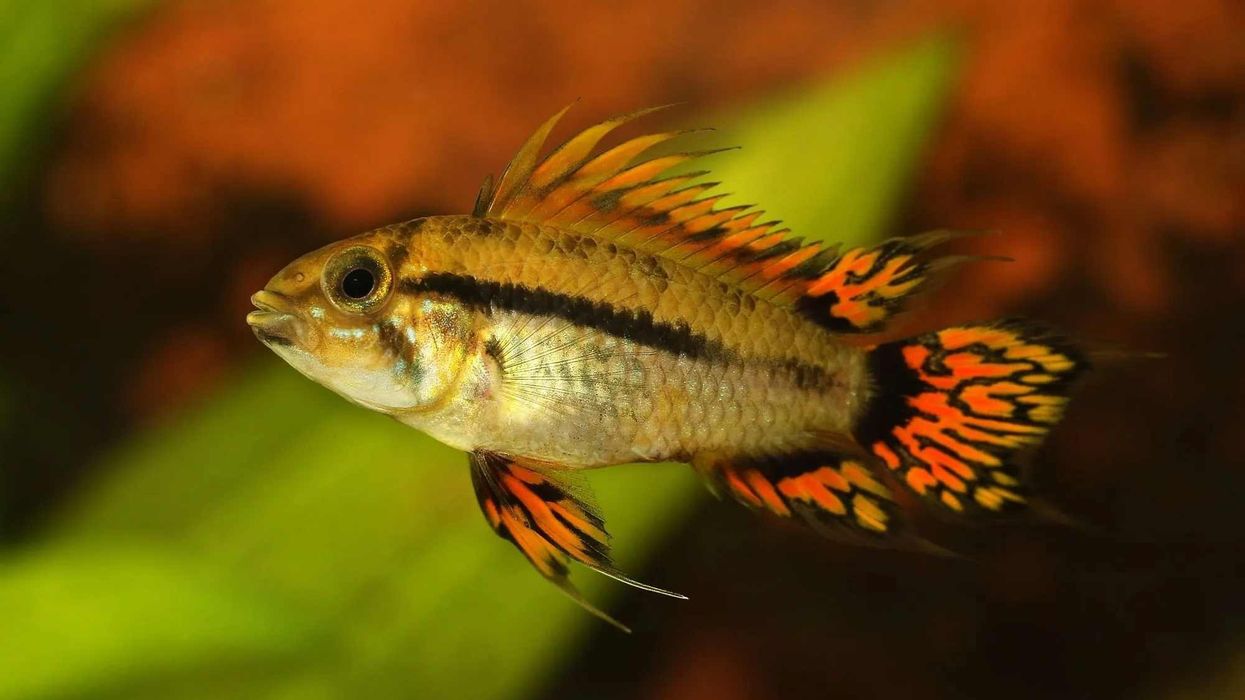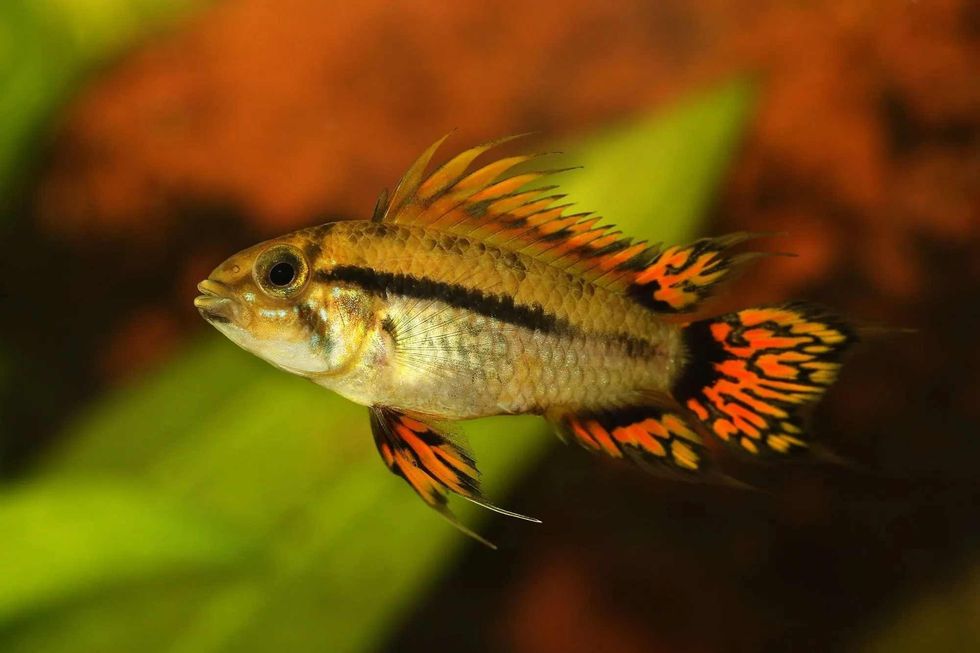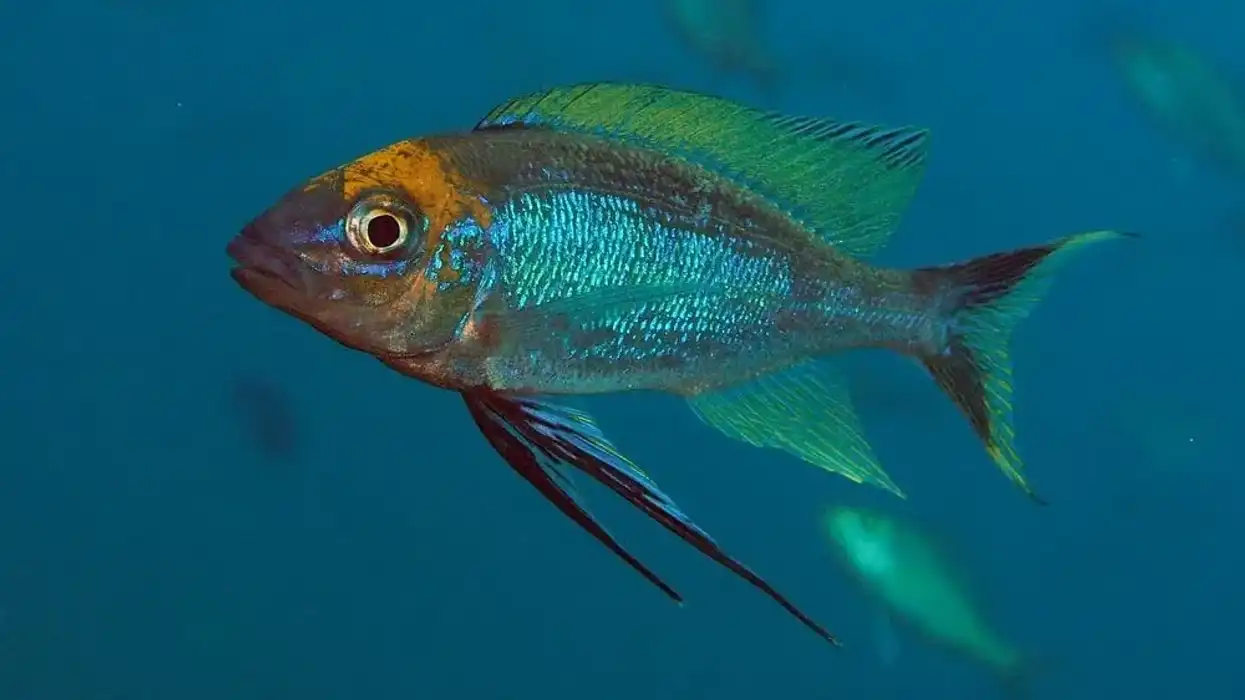The cichlid Apistogramma cacatuoides is a very colorful cichlid. The fish is also called crested dwarf cichlid. The cockatoo cichlids were first described in the year 1951 by Hoedeman. These can easily cohabit with non-cichlids.
The cockatoo cichlid care is not very difficult. The cockatoo cichlid tank mates should not be any aggressive fish. The double full red cockatoo cichlid for sale is readily available on the net.
Inbreeding of these fishes results in colors like sunset, triple red, double red, red, and sun spot. The triple red can produce three different types of color variations. However, such experimentation can lead to spinal problems in the cichlid.
Breeding between a wild fish and a captive-bred fish is ideal. This prevents such spinal problems. Precautions thus should be maintained while breeding these fishes. These fishes can adapt to a variety of living conditions.
Like reading about the cockatoo cichlids? Want to know more about the yellow cockatoo cichlid? Let's move on.
If you like reading about this fish, you may also like reading about the channel catfish and the rainbow trout.
Cockatoo Cichlid Interesting Facts
What type of animal is a cockatoo cichlid?
The cockatoo cichlid is a fish belonging to the phylum Chordata, order Perciformes, and species Cacatuoides.
What class of animal does a cockatoo cichlid belong to?
The cockatoo cichlid belongs to the class Actinopterygii like the swai fish.
How many cockatoo cichlids are there in the world?
The exact number of dwarf cockatoo cichlids is not known.
Where does a cockatoo cichlid live?
The cichlid Apistogramma cacatuoides is a South American fish. This cichlid is found in the Amazon River Basin.
What is a cockatoo cichlid's habitat?
The cockatoo dwarf cichlid is found in the rainforests. The cockatoo dwarf cichlid is found in the shallow streams that are not too big and in lagoons.
Who do cockatoo cichlids live with?
These fishes are found in community fishes. The social groups are formed with a dominant male and a number of females.
How long does a cockatoo cichlid live?
The Apistogramma cacatuoides have a lifespan of five years.
How do they reproduce?
Cockatoo cichlids are essentially cave-breeding fishes. To catch the male's attention, the female will curve her body and display herself. When the male takes notice, he will 'dance' and flash his fins. The female shall lay about 80 eggs on the surface of a cave.
The eggs are red or salmon in color. The male fish will fertilize the eggs and leave the cave. The males patrol outside the caves. The females take care of the eggs.
If a harem exists, then the male visits each cave and breeds with the females. The females have caves within the male's territory. Often females steal a newly hatched fry belonging to another female and add it to their school.
Interesting, isn't it? The cichlids are polygamous. They have either a patriarch or a matriarch arrangement.
The harems that are built of several females defend each other from danger. However, they acknowledge the presence of one male (the dominant one). Once they start free swimming, a group of fry (a school) is led by the female.
What is their conservation status?
Cockatoo cichlids are Not Listed in the International Union for Conservation of Nature (IUCN) Red List.
Cockatoo Cichlid Fun Facts
What do cockatoo cichlids look like?

The shape of the body of the red cockatoo is elongated. The height of the red cockatoo is medium. The mouth of the red cockatoo is big. The red cockatoo has thick lips. The male has a colorful dorsal fin. The dorsal fin of the female is less colorful.
How cute are they?
These fishes, with their colorful scales, are very cute.
How do they communicate?
Cichlids communicate by changing the color patterns on their bodies through hormones and innervation. Patterns, spots, and bands appear and disappear from the body. However, much of these patterns are genetically determined and are specific to the species.
How big is a cockatoo cichlid?
The male cichlid is 4 in (10 cm) in length. A female cockatoo cichlid is 2 in (5 cm) in length. The fish is smaller than the emperor cichlid.
How fast can a cockatoo cichlid swim?
This exact information is not available for this species.
How much does a cockatoo cichlid weigh?
The exact information is not available for the species.
What are the male and female names of the species?
There are no sex-specific names for the males and the females of the species.
What would you call a baby cockatoo cichlid?
A baby cichlid is called a fry.
What do they eat?
The double red cockatoo cichlid's diet is mainly carnivorous. The fish may feed on baby brine shrimp in captivity. The diet may also turn omnivorous in captivity. The cockatoo cichlids feed on insects, crustaceans, shrimp, and worms.
Are they dangerous?
These are not dangerous to humans.
Would they make a good pet?
Yes, cockatoo cichlid care is relatively simple. The care level is not very stringent. The care level is suitable for beginners. These wild South American fishes can be bred in the aquarium as well. The optimal water conditions like temperature need to be maintained in the aquarium.
The cockatoo cichlid compatibility range is diverse, and this fish can be kept with other non-cichlids in the tank or aquarium. The best tankmates are semi-aggressive fish. The tetras or julii cory can be kept as tank mates.
The substrate should be made of dark sand that has fine particles. Rocks and pots (hiding places) should be kept in optimum numbers. Each for a female in the aquarium.
Plants should be kept in the aquarium. These fishes prefer floating plants in the tank. A tank size that is large enough should be chosen.
More than one male should be kept only when the tank is large (30 gal (113.5 l)). A minimum tank size of twenty or 30 gal (113.5 l) should be chosen. The pH level in the water should be acidic or neutral(6.0-7.8) in the aquarium.
A grave mix can be used as substrate as well in the tank or aquarium. Low or subdued lighting should be used in the aquarium.
Plants help to diffuse the levels of the lighting in the tank or aquarium. The temperature needs to be maintained at 75-81 F (23.9-27.2 C) in the tank or aquarium. The breeding temperature varies in the tank or aquarium and needs to be maintained at 78-84 F (26-29 C) in the tank or aquarium.
Water changes and hiding places are important for the fish to survive in the tank or aquarium. The hardness range in the tank for the big mouth Apistogramma is 5-19 dGH. This freshwater fish does not prefer brackish water in the tank. The water movement should not be strong.
The water region should be in the middle. Water changes need to be made to remove nitrates. Feeding these fishes carefully is important as well.
Feeding flake food and pellets are allowed. Live foods like shrimp can form a part of the diet. Vegetable food can be fed as well. The feeding frequency of these dwarf cichlids is high.
Did you know...
Cockatoo cichlids attain sexual maturity in the aquarium within five months.
It is interesting to note that the newly hatched fry are known to change their mothers.
How did cockatoo cichlids get their name?
It is the physical features of the fish that gives it the name. The coloration base of the body is silvery gray.
There is a long horizontal line black in line that runs through the middle. The rays at the top and the bottom of the tail fin are long and bright in color in the males. Several rays in the front that are a part of the dorsal fin in the males are raised higher.
It gives the fish the 'cockatoo' or 'crested' look. The belly in the males and the bottom fins are golden browns in color. The ventral fins in the females are initially yellow, but they turn solid black in color as the female cockatoo cichlid matures. The coloration intensifies as she lays her eggs. The tail fin is more rounded.
What adaptations does cockatoo cichlid have?
The concept of the 'sneaker' males is unique to this fish. The males are territorial and aggressive. Submissive males do not develop the 'cockatoo' coloration. It pretends to be a female and mates with any willing female. In the absence of dominant males, the submissive males reveal their true nature with their colorful fin.
Here at Kidadl, we have carefully created lots of interesting family-friendly animal facts for everyone to discover! For more relatable content, check out these koi facts and rainbow trout facts for kids.
You can even occupy yourself at home by coloring in one of our free printable fish coloring pages.









